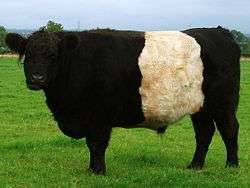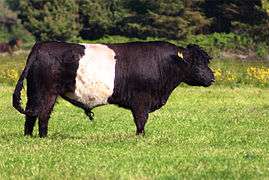Belted Galloway
|
A Belted Galloway in pasture | |
| Conservation status | Watched |
|---|---|
| Nicknames |
|
| Country of origin | Scotland |
| Use | Beef |
| Traits | |
| Weight | Male: 770-850 kg |
| Female: 450-675 kg | |
| Horn status | Polled |
|
Cattle Bos primigenius | |
The Belted Galloway is a heritage beef breed of cattle originating from Galloway in the west side of southern Scotland, adapted to living on the poor upland pastures and windswept moorlands of the region. The exact origin of the breed is unclear although it is often surmised that the white belt that distinguishes these cattle from the native black Galloway cattle may be as a result of cross breeding with Dutch Lakenvelder belted cattle. It is the belt that gives them their name.
Belted Galloways are primarily raised for their quality marbled beef, although they are sometimes milked and purchased to adorn pastures due to their striking appearance.
The black and red coat colours are caused by the same alleles of the MC1R gene, ED for black and e/e for red, as in most other breeds of cattle.
Breed history
The origin of the white belt is unknown, but generally presumed to come from cross breeding with Lakenvelder ("Dutch Belted") cattle.[2] A Polled Herd Book was started in 1852 which registered both Aberdeen-Angus and Galloways. Galloway breeders acquired their own herd book in 1878. The Dun[note 1] and Belted Galloway Association was formed in Scotland in 1921, and in 1951 the name of the organisation was changed to the Belted Galloway Society and dun cattle were no longer registered. It also keeps and records pedigrees for Belted Galloways and oversees the registration of White and Red Galloways.[3][4]
Currently in the UK there is a thriving breeding programme overseen and guided by the Belted Galloway Cattle Society. Belted Galloways were first imported to the United States by a Mrs. McLean of East Kortright, New York. The formerly known American Belted Galloway Breeders Society was formed in the United States on 1 July 1951 by Harry A. Prock of Whitemarsh, Pennsylvania, Gordon Green of Quebec, Canada and Charles C. Wells of East Lansing, Michigan. It is now known as The US Belted Galloway Society Inc.[5]
Population
Belted Galloways, also informally known as Belties, are currently listed with the American Livestock Breeds Conservancy as a "recovering" breed,[6] which means there are more than 2,500 annual registrations in the United States and a global population of exceeding than 10,000. However, this status still means that they were once on the watch list.[7] In 2007 they were formally removed from the UK Rare Breeds Survival Trust's watch list, having recovered sufficiently from the devastation of the foot and mouth crisis of the early 2000s, to have reached in excess of 1500 registered breeding females.[8] 18,390 cattle were registered in the US in 2015.[9]
Characteristics
Galloway cattle are naturally polled. The most visible characteristics of the Belted Galloway are its long hair coat and the broad white belt that completely encircles the body. Its coarse outer coat helps shed the rain, and its soft undercoat provides insulation and waterproofing, enabling the breed to spend winter outside.[10] Black Belteds are most prominent, but Dun and Red Belteds are also recognised by breed societies, the latter being comparatively rare and sought after. A female Belted Galloway cannot be registered in the Herd Book if it has white above the dewclaw other than the belt, but can be registered in the Appendix. A bull can only be registered in the Herd book if it has no other white than the belt.[11]
The dun colour is caused by a mutation in the PMEL gene, the same mutation that causes dun and silver dun in Highland cattle.[12]
Bulls weigh from 1,700 pounds (770 kg) to 2,300 pounds (850 kg) with the usual being around 1,800 pounds (820 kg). Cows weigh from 1,000 pounds (450 kg) to 1,500 pounds (675 kg) with the usual being around 1,250 pounds (565 kg). Calves generally weigh around 70 pounds.[13] Belted Galloways are generally of a quiet temperament, but still maintain a maternal instinct and will protect a calf against perceived threats.[10][14]
They are well-suited for rough grazing land and will utilise coarse grasses other breeds would shun. They are able to maintain good condition on less than ideal pasture, and produce a high quality beef product on grass alone.[4]
Gallery
Notes
References
- ↑ Belted Galloways: The "Oreo-Cookie" Cow
- ↑ Oklahoma State University breed profile
- ↑ "Belted Galloway Society - History". Retrieved 20 June 2015.
- 1 2 "Belted Galloway Cattle". The Cattle Site. Retrieved 20 June 2015.
- ↑ "History and Attributes of Belted Galloway Cattle". Beltie.org. Retrieved 20 June 2015.
- ↑ "American Livestock Conservancy — Belted Galloway". Retrieved 20 June 2015.
- ↑ "Livestock Conservancy - Parameters for Classification". Retrieved 25 August 2015.
- ↑ "That is Farming - Belted Galloway Facts". Retrieved 25 August 2015.
- ↑ "Belted Galloway Society - Newsletter" (PDF). April 2015. p. 4. Retrieved 25 August 2015.
- 1 2 "Rare Breeds Survival Trust — Belted Galloway". Rare Breeds Survival Trust. Retrieved 20 June 2015.
- ↑ "Belted Galloway Society - Registration Criteria". Belted Galloway Society. Retrieved 25 August 2015.
- ↑ Schmutz, S. M. and Dreger, D. L. 2013. Interaction of MC1R and SILV alleles on solid coat colors in Highland Cattle. Animal Genetics 44:9-13.
- ↑ "Belted Galloway Breed Information". Homestead.org. Retrieved 25 August 2015.
- ↑ "Britannic Rare Breeds — Belted Galloway". Retrieved 20 June 2015.
External links
| Wikimedia Commons has media related to Belted Galloway. |
- Southwest Belted Galloway Association
- Belted Galloway Cow Video - Gwynnbrook Farm
- Belted Galloway Society of the United States of America
- Australian Belted Galloway Association
- Galloway Cattle & Beef Marketing Association (Australia)
- University of Massachusetts Belted Galloway Group
- Galloway Cattle Society of New Zealand
- Canadian Galloway Association
- Coat Colours of the Belted Galloway

